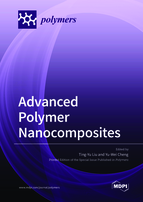Advanced Polymer Nanocomposites
A special issue of Polymers (ISSN 2073-4360). This special issue belongs to the section "Polymer Applications".
Deadline for manuscript submissions: closed (31 May 2020) | Viewed by 63917
Special Issue Editors
Interests: polymer nanocomposites; electrochemical and atmospheric plasma-induced polymerization; opto-electric sensing; nanomaterial self-assembly; drug controled release
Special Issues, Collections and Topics in MDPI journals
Interests: polymer nanocomposites; polymer synthesis; organic–inorganic nanohybrids
Special Issues, Collections and Topics in MDPI journals
Special Issue Information
Dear Colleagues,
Polymer nanocomposites are currently of industrial interest and popular in the field of nanomaterials. As a result, scientists are working to improve the performance of polymeric matrices and inorganic nanomaterials, such as via light magnetic behaviors, electrical/thermal conductivity, toughness, stiffness and mechanical strength. The inorganic quantum dots/nanoparticles, nanorods/nanotubes, and 2D materials (such as graphene-based nanosheets) can be decorated in the polymer matrix by chemical synthesis or physical blending for improved performance. Thus, the technology with which to fabricate the homogeneous dispersion of the fillers in the polymer matrix has been crucial to the field of nanomaterials.
This Special Issue, “Advanced Polymer Nanocomposites”, will collect the innovative original research and review papers that focus on the scientific discussion and practical applications in the field of functional polymer nanocomposites. Examples of acceptable research topics are: (a) green energy, (b) biomedical materials, (c) opto-electronics and sensing, (d) coating, (e) carbon, (f) magnetic materials, and (g) other functional polymer nanocomposites. Topics of special interest include but are not limited to the preparation, chemical synthesis, structural design, material selection, characterization, morphology and applications of advanced polymer nanocomposites. We hope that the Special Issue will promote academic research exchange, as well as identifying and responding to the tremendous challenges currently faced in this burgeoning field.
Dr. Ting-Yu LiuDr. Yu-Wei Cheng
Guest Editors
Manuscript Submission Information
Manuscripts should be submitted online at www.mdpi.com by registering and logging in to this website. Once you are registered, click here to go to the submission form. Manuscripts can be submitted until the deadline. All submissions that pass pre-check are peer-reviewed. Accepted papers will be published continuously in the journal (as soon as accepted) and will be listed together on the special issue website. Research articles, review articles as well as short communications are invited. For planned papers, a title and short abstract (about 100 words) can be sent to the Editorial Office for announcement on this website.
Submitted manuscripts should not have been published previously, nor be under consideration for publication elsewhere (except conference proceedings papers). All manuscripts are thoroughly refereed through a single-blind peer-review process. A guide for authors and other relevant information for submission of manuscripts is available on the Instructions for Authors page. Polymers is an international peer-reviewed open access semimonthly journal published by MDPI.
Please visit the Instructions for Authors page before submitting a manuscript. The Article Processing Charge (APC) for publication in this open access journal is 2700 CHF (Swiss Francs). Submitted papers should be well formatted and use good English. Authors may use MDPI's English editing service prior to publication or during author revisions.
Keywords
- green energy
- biomedical materials
- opto-electronics and sensing
- coating
- carbon
- magnetic materials
- other functional polymer nanocomposites








